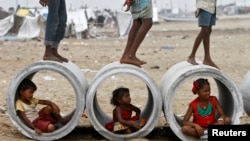A commercial painter by trade, K. Raja dreamed of setting up his own business in Surya Nagar slum, in Chennai, where he had lived all his life.
But his dream faded last February, when he and about 1,000 other families were evicted with a day's notice and relocated 20 km (12.4 miles) away, their homes demolished.
Now living in a 390-sq-ft (36.2-sq-mt) home in an eight-story building surrounded by similar blocks of flats, Raja has been unable to find a job. His home floods when it rains, and his daughter often falls ill from the constant damp.
"There we had a community, we had jobs, and we lived with some dignity in our own homes," he said.
"Here, I can't find a job, I don't know my neighbors, and the hospital is far away. We have been dumped here like orphans with no help."
The re-settlement site in Perumbakkam is the newest of three colonies built by Tamil Nadu state over nearly two decades to house slum dwellers and those displaced by the Indian Ocean tsunami of 2004 and the Chennai floods of 2015.
More than 52,000 families have been relocated to sites on the outskirts of Chennai as slums were flattened to make way for roads and flyovers. Perumbakkam is the biggest with almost 24,000 units.
Residents have opposed the sudden nature of the evictions, and lack of compensation. They say their new homes are plagued with problems from leaky pipes and faulty electrical fixtures to a lack of public transport, schools and hospitals.
City officials say there was no option but to evict them and acknowledge shortcomings in the new sites.
"We are aware that these sites are far, but we do not have space for resettling so many people in the city," said K.S. Kandasamy, deputy commissioner of the municipal corporation.
"We are considering giving free bus passes, so people can commute more easily, and we are addressing damages in the homes and services. It will take some time to adjust," he said.
Policy
About a third of India's 1.25 billion population lives in cities, with numbers rising every year as tens of thousands of people leave villages to seek better prospects. Many end up in overcrowded slums, on the streets, and under bridges.
A shortage of affordable housing has led to up to 37 million households - a quarter of the urban population - living in informal housing including slums, according to social consultancy FSG.
Tamil Nadu, the most urbanized major state in the country with nearly half its 78 million people living in cities, was among the first states to create a Slum Clearance Act and a Slum Clearance Board.
Under the act, the government must identify slums, declare them to be slums and then build permanent homes for residents, or improve conditions in the slums.
Yet the state has only declared slums twice: about 1,200 at the time the Board was set up in 1971, and 17 more in 1985.
The state, known as a hub for car manufacturing and information technology services, also does not have a policy for the support and resettlement of slum dwellers, despite setting up a committee in 2011 to formulate a policy, activists say.
"It's a piecemeal approach now, and residents pay a high price," said Vanessa Peter at the non-profit Information and Resource Centre for Deprived Urban Communities (IRCDUC).
She said the Slum Act should be amended to address improve land tenure, ensure adequate housing, right to land and public and social infrastructure facilities for the urban poor.
Further impoverishment
Campaigners said where possible the state should opt for in situ, or on location development rather than relocation which costs up to 20 times more than redevelopment.
According to civic group Transparent Chennai, it would take less than 3 percent of the city's land to house all the slums within city limits.
"Resettlement has become a euphemism for state-sponsored segregation and dispossession of the urban poor," said Shivani Chaudhry, executive director of Housing and Land Rights Network.
"It is resulting in further impoverishment and marginalization of already deprived urban communities, resulting in dispossession and creation of ghettos," she said.
In Perumbakkam, the brightly painted blocks of flats stand amid stagnant pools of water just a mile from the highway dotted with gleaming glass-and-chrome IT offices and sleek hotels.
In one of the blocks, the floors are pockmarked, the walls have damp patches, electrical fittings are hanging loose, and a lift is broken. A resident says a child died after falling from a ledge, which does not have a safety grill.
Kalyani P and her husband, who were moved from a slum about 25 km away, have re-painted their apartment twice, replaced the tiles and put in new electrical fittings.
Even so, the family had to sleep in the corridor when it rained as the flat would flood, and the mossy patches on the ceiling have returned.
"We thought we now own a proper home that we can leave to our children. But it probably won't last even our lifetime," she said.
"We were fine in the slum, doing our work, earning money and caring for our family. What is the point of living here like this?"








